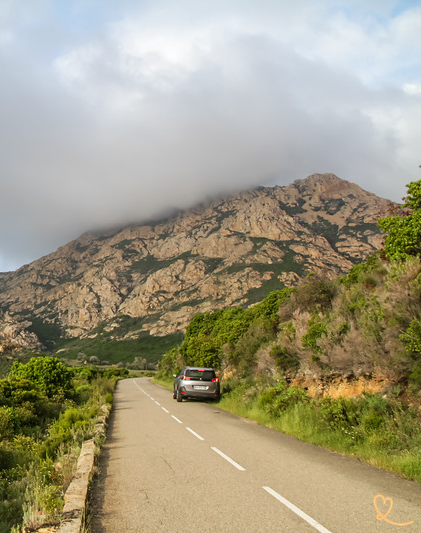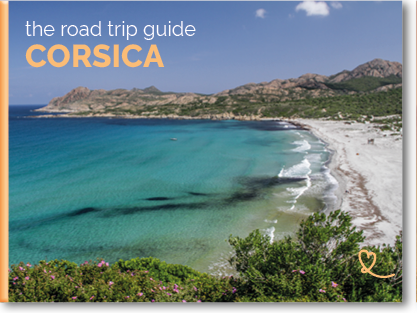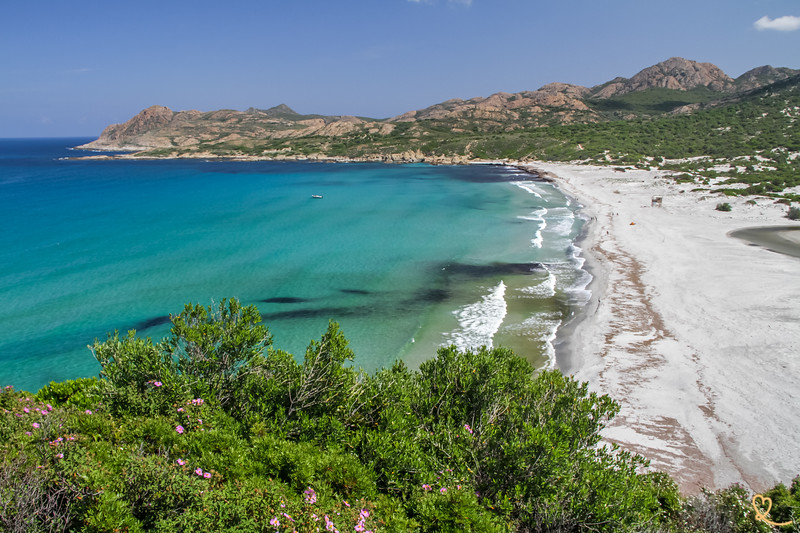A getaway to Bastia? Don’t miss a visit to Sainte-Marie-de-l’Assomption Cathedral! Located in the heart of the citadel district, this 17th-century cathedral is a jewel of Corsican heritage. We were seduced as much by its Baroque architecture as by its opulent interiors, marked by a profusion of details and precious materials.
In this article, you’ll find some useful tips to help you prepare for your visit and have a wonderful time!

This guide is completely independent, based on our experiences. We visited the region anonymously, making our own choices and paying our bills in full.
Why visit Sainte-Marie-de-l’Assomption Cathedral
Is Bastia Cathedral worth the effort? Our opinion:
Yes, the cathedral is well worth a visit. We were dazzled by its original, opulent decor, punctuated by several beautiful pieces of sacred art. Paintings, statues, organs, frescoes: you’ll be lost for words! It’s one of Bastia’s best activities!

Why is Saint Mary’s Cathedral famous?
Sainte-Marie Cathedral is famous for its exceptionally rich Baroque decor. Protected as a Historic Monument since 2000, it houses many remarkable works of art. Last but not least, the cathedral is also at the heart of the Assumption celebrations, when its solid silver statue of the Virgin Mary is carried in solemn procession through the streets of Bastia, bringing together the faithful and curious visitors.

Our favorite moment
The cathedral’s choir caught our eye in particular. We loved the profusion of elements, between the colorful stained glass windows, the almost lyrical niche dedicated to the Virgin, the polychrome marble altar and the gilded stucco details that adorn the space.

History in brief
Here are the key dates in the cathedral’s history:
- 1488: Construction of the original church
- 1590: The church becomes a cathedral
- 1604-1619: Construction of the second building
- 1660-1670: Construction of the western façade in a Baroque style influenced by Genoese tradition
- Late 19th century and 1938: Restoration of the facade and bell tower
- 1940: Consolidation of bell supports
- 1996-1999: Restoration of the west facade and bell tower
- 2002-2004: Restoration of side facades and apse

Access: Sainte-Marie-de-l’Assomption Cathedral, Bastia
Where is Sainte-Marie Cathedral?
The cathedral is located in Bastia’s city center, at 2 Rue Notre-Dame. It’s close toBastia’s Saint-Jean Baptiste church and the colorful streets of the citadel district.

How to get there?
Access to the cathedral is easy from many points in the city. You can reach it on foot from the Port of Bastia in 8 minutes or from the train station in 20 minutes.
The city’s atmosphere of dolce vita is sure to please strollers on foot! The local Muvistrada bus network crosses the city, with the nearest stop to the cathedral being “Place de Gaulle”.
OUR TIPS FOR RENTING A CAR IN Corsica
- Compare prices on our preferred platform: DiscoverCars – one of the best rated sites.
- Choose a car that is powerful enough (the roads are steep) but compact (some passages are narrow).
- Think of thecomplete insurance (some roads are tortuous and narrow).
- There is a lot of demand, book it early.

Parking
The Citadelle parking lot, a 1-minute walk away, is the most convenient parking option.
THINGS TO DO AROUND Bastia
Discover all our articles on the region:
- What to do in Bastia
- Where to sleep in Bastia
- Luxury hotels in Bastia
- Best restaurants in Bastia
- Visit the Palais des Gouverneurs (coming soon)
- Visit the Bastia Citadel (coming soon)
- Rent a car at Bastia airport
- Ajaccio or Bastia: where to go?
Useful tips: duration, schedules, eating…
Best time to visit
We recommend an early morning visit, between 8:30 and 10 a.m., when the morning light sublimates the ochre facade. We particularly enjoyed the sunlight streaming through the stained glass windows in the late afternoon, creating a unique atmosphere. For greater peace and quiet, avoid times of religious celebration and prefer periods out of the tourist season, especially July and August.
Length of visit and main difficulties
Allow around 30min to explore the cathedral. The floor is flat and smooth, with no particular difficulties.
Note, however, that the site is partially accessible to people with reduced mobility, with a dedicated entrance from Rue Saint Charles, but some side chapels and the altar have steps.

Advice on how to visit
You can visit the church at your leisure. However, we recommend that you take a look at the exterior before exploring the treasures inside.
USE OUR GUIDE TO PLAN A
DREAM TRIP TO Corsica
All the information you need for your trip:
- 7 maps that make planning easier
- 130+ pre-selected locations
- Practical advice
- + 220 photos to help you choose

Visiting with children
The visit is not particularly suitable for children, but can be an opportunity to introduce them to an important part of Corsican history.
Schedules and rates
St. Mary’s Cathedral is open daily from 8am to 12pm and from 2pm to 5pm, except on Sundays and during religious services.
The access and the visit are free.
Please note that the cathedral is not lit. To illuminate both the entire cathedral and the showcase of the solid silver Madonna, you need to go to the coin slot to the left of the main entrance. You can only insert 50-cent coins (for 1min30 of illumination) or €1 coins (3min of illumination).

Catering
Find out more in our article Where to eat in Bastia!
Majestic architecture
A Baroque façade
Much altered in the 19th century, this façade has undergone several restorations. We were impressed by its neoclassical style, with three doors in the façade. This feature heralds a basilica with three naves.
You’ll notice that it’s organized in three sections, framed by Corinthian pilasters and topped by antique-style pediments, creating a striking volume.
In keeping with the canons of Italian architecture, we note that the church has just one bell tower, a campanile, built in 1620 at choir level, rising to a height of 38m.

Grand interiors
Inside, we were struck by the sheer size of the building (44.70 m long, 23.35 m wide and 17.10 m high). Its five-bay nave unfolds into three majestic vessels. We liked the contrast between the flat roof on the central nave and the single-plane roof on the side aisles.

You’ll notice that the choir, with its hemicyclic chevet and radiating roof, is set back in height. Observe the delicate floral ornaments here!

Rich ornamentation
A wealth of details
Pay close attention, as a multitude of ornamental details lurk in every nook and cranny of the church. We loved the floor pavement, with its elegant geometric patterns in a variety of Italian (Carrara and Levanto) and Corsican (Corte, Bevinco) marbles.

Look up! We were particularly impressed by the gilded stucco decoration of the capitals, friezes and cornices, created by Francesco Marengo in 1621. The central medallion of the vault features a fresco by Geronimo Sari, completed in 1835.

Beautiful pieces of sacred art
In addition to the silver statue of the Assumption, a masterpiece created in 1852 by Gaetano Macchi and the cathedral’s landmark work, the site is also home to a varied and harmonious collection of religious paintings. We were particularly struck by the Assumption of the Virgin, painted by Leonoro d’Aquila in 1517. It’s even said to be the oldest painting in Bastia (photo below).

Among its many works of art, we also admired Leonoro dell’Aquila’s wooden altarpiece of the Assumption, dating from 1512. In the choir, you can also admire the 18th-century polychrome marble high altar and the walnut stalls by Giuseppe Fontana, dating from 1871.

Subscribe to our Newsletter
- Get away from it all with Region Lovers’ beautiful destinations!
- Once a month
- Advertising-free
Frequently asked questions
Why does Bastia Cathedral bear the nickname Santa Maria Assunta?
The current building replaces a modest church built in 1489, named Santa Maria della Consolazione or Santa Maria del Soccorso (Our Lady of Consolation or Our Lady of Good Help). We learned that its apse was leaning against an imposing rock, earning it the popular nickname of Santa Maria Assunta, meaning “the leaning one”. You’ll discover that this unique configuration testifies to the ingenuity of the builders of the time in adapting to the rugged terrain.
What is the significance of the hats hanging in the choir?
The episcopal hats hanging above the choir belong to the bishops buried in the cathedral crypt, a tradition symbolizing their spiritual presence.
PLAN YOUR TRIP TO Corsica
Inspiration destinations

Best of
- The most beautiful beaches of Corsica
- The most beautiful villages of Corsica
- The most beautiful cities of Corsica
- The most beautiful destinations in Corsica
- The museums of Corsica
- Hidden gems in Corsica
- The most beautiful natural pools
- What to do in North Corsica
- Best things to do in South Corsica
- Canyoning in Corsica

Where to stay





